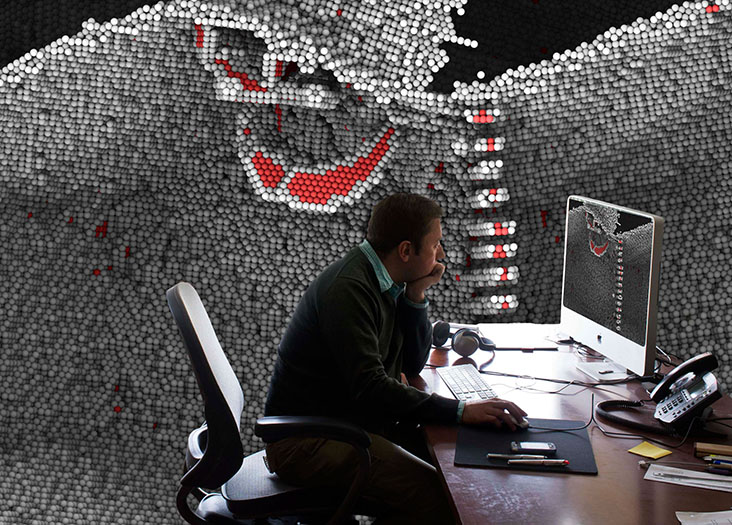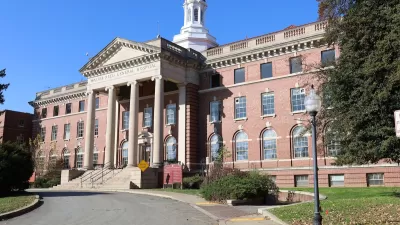Michael Demkowicz says that steel, aluminum, and concrete are among materials we understand least, but all have big possibilities for engineers.

For Michael Demkowicz, some of the greatest scientific mysteries and major engineering opportunities lie in everyday materials. “Structural materials are sometimes seen as low-tech,” he says. “Who thinks about steel, who thinks about aluminum, who thinks about concrete? But those are probably some of the materials we understand the least.”
One mystery of structural materials is why they degrade under corrosion, heat, and radiation—their performance isn’t what it could be by a long shot. Theoretical performance levels are much higher than what current materials are capable of, says Demkowicz, an associate professor in the Department of Materials Science and Engineering. This has major practical implications. The lack of high-performance structural materials makes it harder to develop efficient energy production, resilient infrastructure, and sustainable transportation, he said. The combination of the technological need and the scientific mystery is “a huge opportunity that cries out to be taken advantage of.”
Demkowicz’s lab models the physics of structural materials to better understand how they degrade, and ultimately break down. He aims to use the models to design new materials that are resistant to radiation damage, fracturing, and corrosion. The result could be jet engines that run more efficiently, bridges and buildings that withstand earthquakes, and nuclear power plants that produce less waste.
In all those cases—environmental conditions, mechanical loading, and radiation—failure is ultimately related to the formation and growth of defects in the metal’s crystal structure, Demkowicz says. The challenge is controlling the defects. “Can we do some kind of ‘defect engineering’ to make the material behave the way we want?”
An ideal behavior for structural materials is self-healing. Demkowicz’s lab is on the trail of several methods of producing materials that repair microscopic damage from environmental and mechanical stresses. One potentially groundbreaking method is a surprise discovery that emerged from research about hydrogen embrittlement, which occurs when hydrogen atoms infiltrate metals in acidic environments. Demkowicz and his graduate student, Guoqiang Xu, discovered that, under the right conditions, putting metal under tension can close rather than open microscopic cracks.
Another method addresses helium embrittlement, which occurs when metals are exposed to radiation. Demkowicz’s lab is designing metals that spontaneously form microscopic channels in the presence of embedded helium atoms. The channels would allow the helium to escape rather than form tiny bubbles that weaken the metal.
The intimate connection between basic research and technology is readily apparent in the field of materials. The common name for the field, materials science and engineering, makes the connection explicit. Demkowicz and Xu chose to publish their crack-healing paper in a physics journal rather than in a materials journal to highlight the fundamental science of the discovery.
The effort to develop self-healing metals is one example of technological innovation emerging from basic research. Given the abundant opportunities for basic research in structural materials, we’re likely to see many more, says Demkowicz. “In my own research I see it all the time,” he says. “We discover something new and unexpected that helps us understand a material better, and it’s never long before we come up with an idea of how to use it.”
-by Eric Smalley
FULL STORY: MIT Spectrum

Planetizen Federal Action Tracker
A weekly monitor of how Trump’s orders and actions are impacting planners and planning in America.

Map: Where Senate Republicans Want to Sell Your Public Lands
For public land advocates, the Senate Republicans’ proposal to sell millions of acres of public land in the West is “the biggest fight of their careers.”

Restaurant Patios Were a Pandemic Win — Why Were They so Hard to Keep?
Social distancing requirements and changes in travel patterns prompted cities to pilot new uses for street and sidewalk space. Then it got complicated.

Platform Pilsner: Vancouver Transit Agency Releases... a Beer?
TransLink will receive a portion of every sale of the four-pack.

Toronto Weighs Cheaper Transit, Parking Hikes for Major Events
Special event rates would take effect during large festivals, sports games and concerts to ‘discourage driving, manage congestion and free up space for transit.”

Berlin to Consider Car-Free Zone Larger Than Manhattan
The area bound by the 22-mile Ringbahn would still allow 12 uses of a private automobile per year per person, and several other exemptions.
Urban Design for Planners 1: Software Tools
This six-course series explores essential urban design concepts using open source software and equips planners with the tools they need to participate fully in the urban design process.
Planning for Universal Design
Learn the tools for implementing Universal Design in planning regulations.
Heyer Gruel & Associates PA
JM Goldson LLC
Custer County Colorado
City of Camden Redevelopment Agency
City of Astoria
Transportation Research & Education Center (TREC) at Portland State University
Camden Redevelopment Agency
City of Claremont
Municipality of Princeton (NJ)




























